Studio Visit
Stephen Wong on His Technicolor Landscapes, Where David Hockney Meets Anime
These vibrant works have been increasingly in-demand.
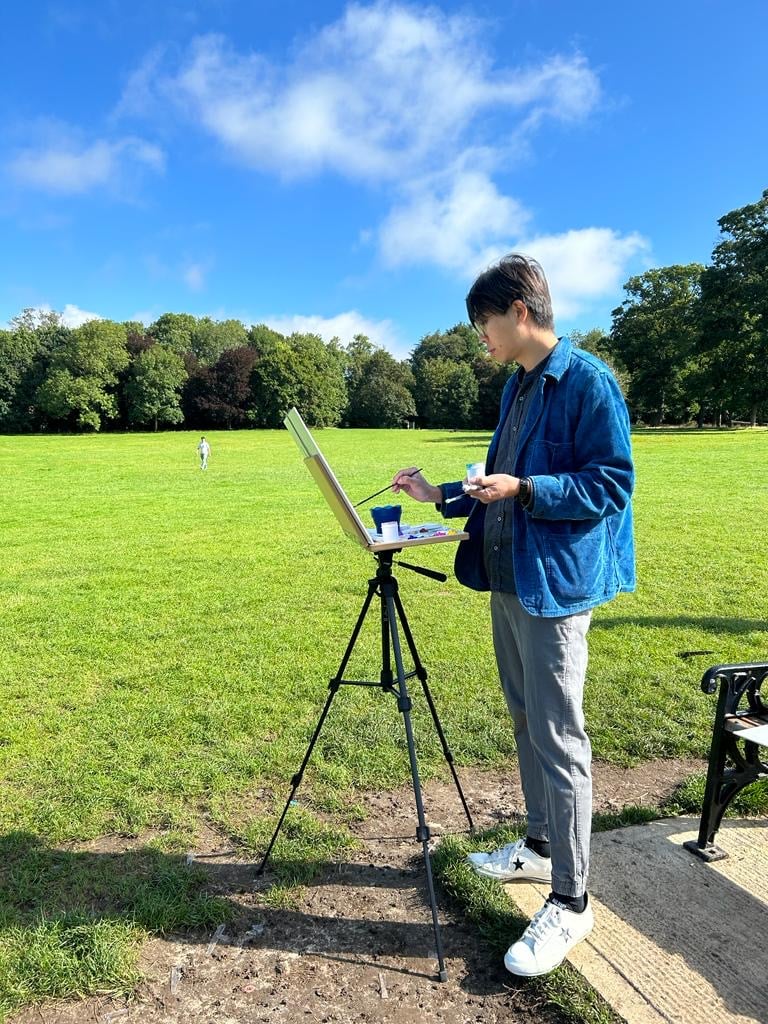
These vibrant works have been increasingly in-demand.

Vivienne Chow

It has been full year for Stephen Wong Chun Hei, the rising market star who has been gaining a solid following—collectors are increasingly hungry for his unique landscape paintings inspired by his native Hong Kong.
In addition to a string of gallery shows, the 37-year-old created a gigantic 33-foot-long painting that became a permanent installation at a shopping center; he also took up artist-in-residence at Oxford University’s Jesus College, where he was commissioned to create new work as part of his visiting fellowship.
But not everything was within Wong’s expectations. For instance, the sudden appearances of his paintings at several auctions this year, following his auction debut in 2022, caught him off-guard. One of the lots was the Phillips sale of a painting he had exhibited last year, and it earned him a new auction record. Despite being a sought-after artist in the primary market, he still has mixed feelings towards auctions.
“It has been a successful and fulfilling year, but at the same time, it’s been a complicated year as well. It’s complicated not just in terms of artistic creations, but also dealing with the art world and art market in a way that I’ve never encountered before,” Wong said on the phone from his Hong Kong studio.
But this has not stopped Wong from gearing himself up for another ambitious year. In the midst of preparing for 2024, Wong takes a little break and gives us a virtual tour to his studio in Hong Kong.
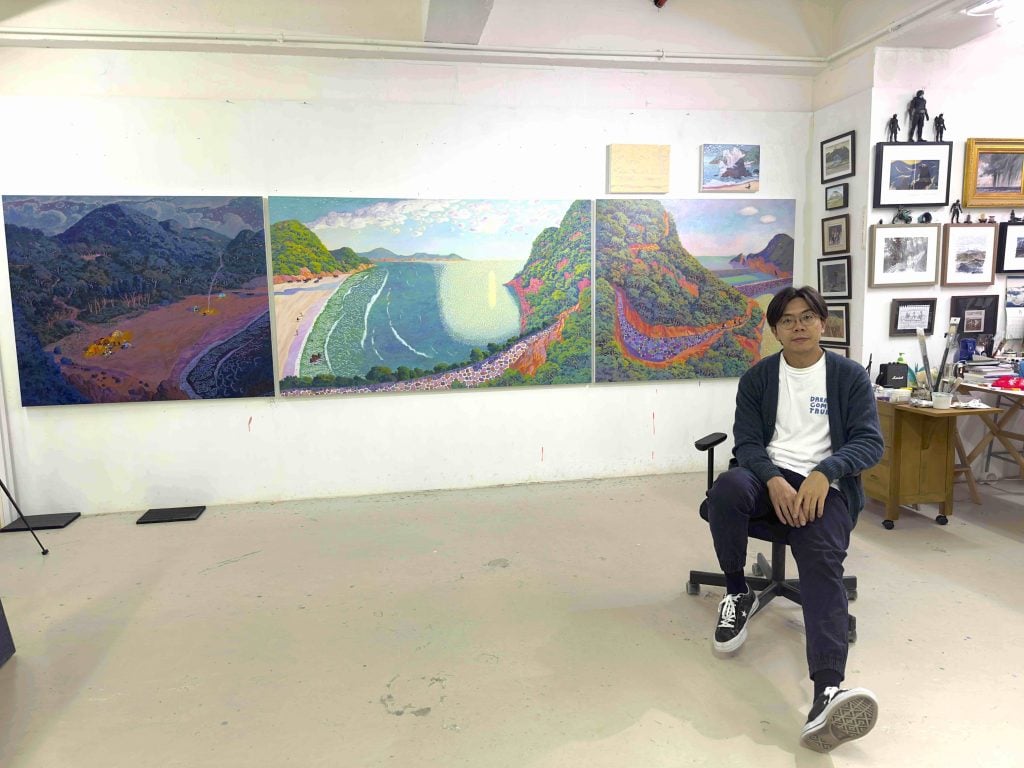
Stephen Wong Chun Hei at his studio in Hong Kong. Photo courtesy Stephen Wong Chun Hei.
Tell us about your studio.
My studio locates at Fo Tan, Hong Kong, it’s a flat inside an industrial building. I found it through an agent in 2021.
What made you choose this particular studio over others?
When I first came into the flat, I was fascinated by the sunlight from the window which made me feel so energetic. And the wall space is big enough for me to work on big canvases.
Do you have studio assistants or other team members working with you?
No, I work on my own in the studio.
How many hours do you typically spend in the studio, what time of day do you feel most productive, and what activities fill the majority of that time?
Usually I arrive my studio at 10am. And then I will spend around seven to eight hours a day there. I am quite productive during the daytime. I mainly paint on canvas in studio.
What is the first thing you do when you walk into your studio?
I water my plants and also drink a cup of water.
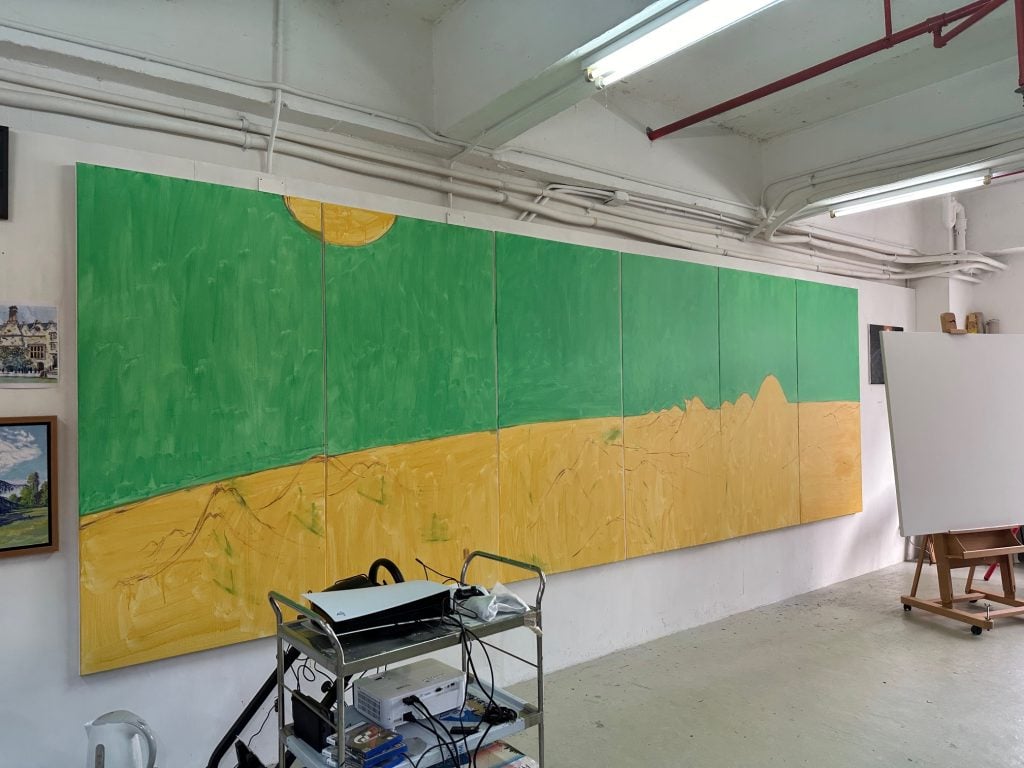
Work in progress part of the 11-panel painting. Photo courtesy Stephen Wong Chun Hei.
What is a studio task on your agenda this week that you are most looking forward to?
I need to get start on an 11-panel painting for my upcoming solo show at Gallery Exit in Hong Kong in March next year, coinciding with Art Basel Hong Kong. This is the biggest piece I have ever done in this studio.
What are you working on right now?
I am working on a new body of works which are all for my next solo show in Hong Kong. This time I paint the landscapes of Hong Kong with a galaxy background.
What tool or art supply do you enjoy working with the most, and why?
I love to use golden heavy Body acrylic paint on my canvases. Their paint remain very bright and saturated after it dries, unlike other acrylic paint which turns matte. Its texture is close to oil paint and it dries very quickly, which suits the way I work. I was recommended by Gallery Exit’s Aenon Loo when he first came to my studio in 2013. I stopped doing oil painting because I’m allergic to oil paint.
I recently purchased a painting cart from Seikaido, an art tool shop in Japan. I like the wooden structure and the drawers in it.
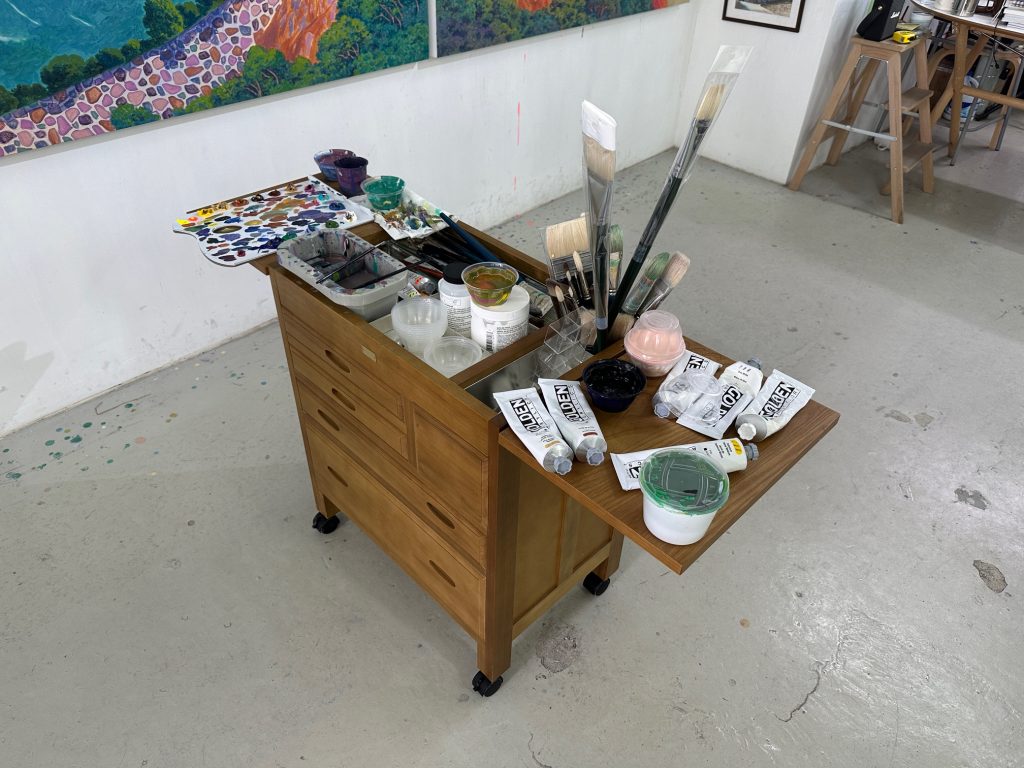
Painting cart from Seikaido. Photo courtesy Stephen Wong Chun Hei.
What kind of atmosphere do you prefer when you work?
Sometimes I listen to the commentary programs on YouTube, gentle instrumental music, or sound of the nature such as sea waves, waterfall, or forest ambience when I paint. I also have a projector connected to the PlayStation 5. I usually play for an hour from 6 p.m. onwards as a reward for myself after a day’s work. It’s also the only time I can play because I need to wait until sunset—I do not have curtains for my studio’s windows. I even purchased a wheel controller recently so I can virtually enjoy car racing with video games.
How do you know when an artwork you are working on is clicking? How do you know when an artwork you are working on is a dud?
I’m not the type of artist who gives up on working on a painting easily. To me the way to know whether a work is clicking is to keep sketching. I explore and look at the scenery and landscapes through sketching. This is a precious process. It is also a form of documentation of my condition at that moment.
When I went to Jesus College at Oxford University artist-in-residence program supported by HomeArt, I just kept sketching and painting every day. I enjoyed the entire process and experience.
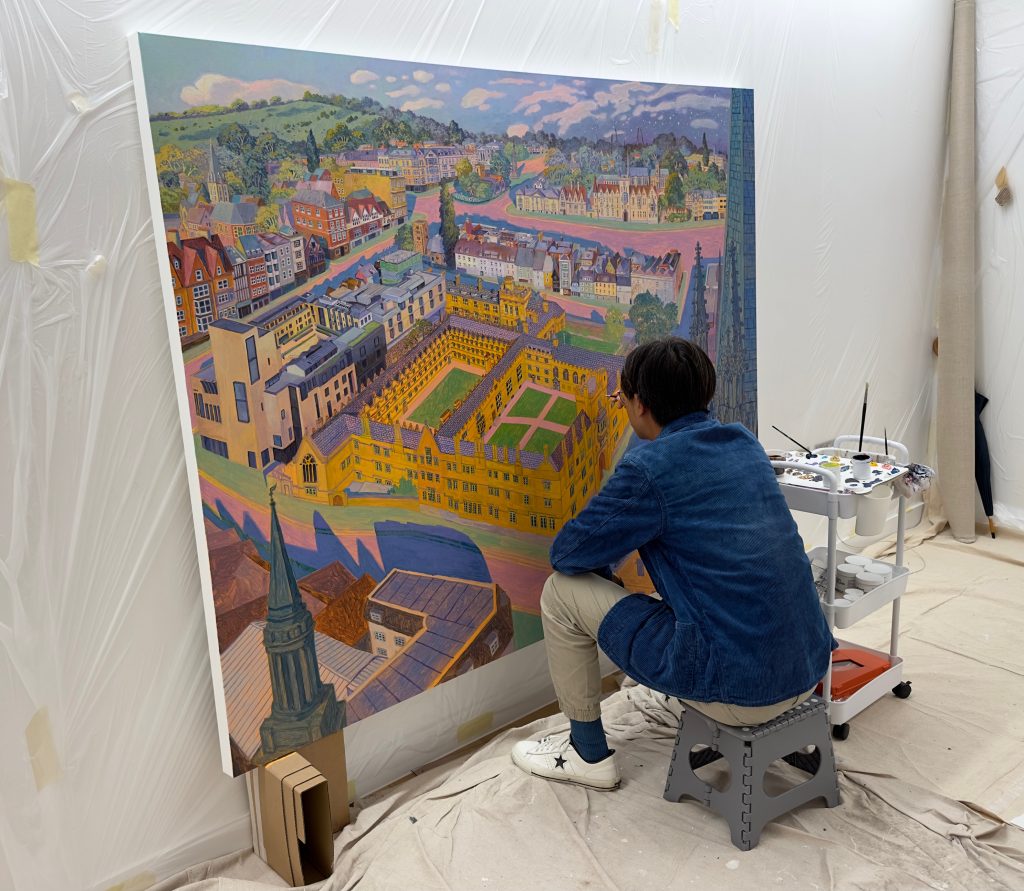
Stephen Wong Chun Hei conceived a painting of Jesus College during his residency with Jesus College, Oxford University. Courtesy of the artist.
When you feel stuck while preparing for a show, what do you do to get unstuck?
I like to go hiking or for a walk whenever I felt tired or stuck. My paintings are drawn from my experiences in hiking and observations of a place. When I feel stuck, it means I run out of materials for my work. By going on a hike or even just a walk, I can always get some inspirations.
What images or objects do you look at while you work? Do you have any other artist’s work in your studio?
It’s fair to say that I’m a collector of Japanese anime figures. I have at least 200 pieces. When I take a rest in the studio I like to look at them. At art school, we were often told to practice our drawings with those classic sculptures from art history, but I always wondered why we could not draw anime figures. In my mind they are the same.
Manga, anime, and video games are important to my practice. Painting is the creation of a virtual world, and through painting I transform and reimagine my experiences on the canvas with my paint brushes. When I’m working on my painting, I get very immersed in the process as if I were in that virtual world that I’m creating.
They also have an impact my perspective. I approach my paintings with a bird’s eye view, rather than a first-person perspective, despite the fact that the images I paint are drawn from my first-hand observation. It’s like some of the games I play, such as Age of Empire or G.T.A. This perspective also helps me better understand traditional Chinese landscape ink paintings because they also share a similar perspective. I’m often asked if I have any inspirations from Chinese landscape paintings because I do landscape paintings too, but in fact there’s no such direct connection.
There’s an obvious connection between my choice of color palette and the saturation of colors in anime and video games. But I feel that artistically I’m more influenced by David Hockney and Felix Valloton.
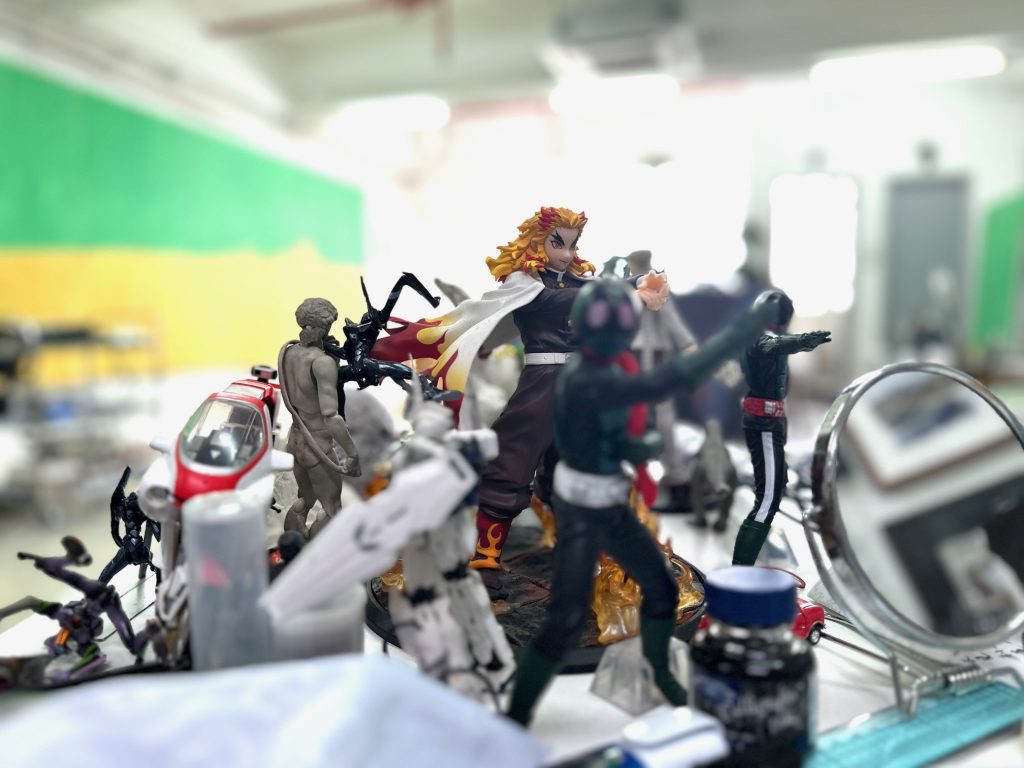
Stephen Wong Chun Hei’s collection of anime figures, including his favorite character, Rengoku Kyojuro, the Flame Hashira, from Demon Slayer (middle, yellow hair). Courtesy of the artist.
What’s the last museum exhibition or gallery show you saw that really affected you and why?
This year I visited the permanent exhibition in Ashmolean Museum and I came across to the paintings of Walter Sickert. I love the brushworks he used and the daily sceneries he tried to depict on his paintings.
Is there anything in your studio that a visitor might find surprising?
Many visitors said that my studio is very clean and tidy but I don’t really agree with them. People always have the impression that an artist’s studio is messy, but that is a wrong stereotype.
Describe the space in three adjectives.
Spacious, safe, cosy.
What’s the last thing you do before you leave the studio at the end of the day?
Quite embarrassing…I say to the studio, “please wait for me to come back tomorrow.”
More Trending Stories:
Art Dealers Christina and Emmanuel Di Donna on Their Special Holiday Rituals
Stefanie Heinze Paints Richly Ambiguous Worlds. Collectors Are Obsessed
Inspector Schachter Uncovers Allegations Regarding the Latest Art World Scandal—And It’s a Doozy
Archaeologists Call Foul on the Purported Discovery of a 27,000-Year-Old Pyramid
The Sprawling Legal Dispute Between Yves Bouvier and Dmitry Rybolovlev Is Finally Over